
Sand play areas for children in large cities were originally known as sand gardens and were subsequently called playgrounds as their popularity increased. The introduction of sand gardens in Boston in 1886 has been credited as the beginning of the playground movement in America. Even though the German play movement had gained strength in America in the early 1820s when a crude outdoor gymnasium with gymnastic equipment was built in Salem, Massachusetts, interest in using the outdoor gymnasium dwindled. The explosive excitement of the sand gardens experiment that began in 1886 established the beginning of the playground movement.1
The earliest known use of sand brought into a public area for children’s play was in the public parks of Berlin, Germany, in 1850. Friedrich Froebel, the founder of the kindergarten, promoted the importance of free play as well as nature play for children. His model kindergarten plans emphasized the need for opportunities for contact with natural materials to be designed into his concept of a garden for play. The kindergarten movement spurred the use of sandboxes in German schools and homes.2
The introduction of sand gardens to America was prompted by Dr. Marie Zakrsewska, who while visiting in Berlin in 1885 observed children playing in heaps of sand in the public parks under the supervision of the police. She wrote a letter to Kate Gannet Wells, the chairman of the executive committee of the Massachusetts Emergency and Hygiene Association (MEHA), which resulted in a large heap of sand being placed near the Parmeter Street Chapel and the West End Nursery in Boston. The subsequent excitement of children enthusiastically playing in the sand encouraged more piles of sand to be placed the following year in the yards of the Children’s Mission Parmenter Street Chapel and the Warrenton Street Chapel. Within two years there were ten sand gardens, and twenty-one sand gardens by 1899.3
The early sand gardens were built in poor neighborhoods near settlement houses that were home to the many immigrant families that were arriving in America. The efforts of charitable organizations to rescue children from the dangers of the slums resulted in the beginning of the child-saving movement, which worked to improve the conditions of children by establishing playgrounds and recreation areas as well as other programs to alter the effects of the poverty they experienced. The necessity of building playgrounds in the large cities’ slums was the prevailing thought, since it was felt that the small towns and the countryside offered ample opportunity for nature play, and the wealthy families in the cities had large yards for their children to enjoy.4
The use of sand gardens spread quickly to include school yards when the Massachusetts Emergency and Hygiene Association was given permission to use vacant school yards in the summer for sand piles. Eventually, the MEHA turned the responsibility for the operations of the playgrounds over to the school boards and park commissions.5
In 1888, G. Stanley Hall wrote The Story of a Sand-Pile, where he described the high play value of sand. This short story details the neighborhood boys enjoying a sand-pile for an entire summer that a mother had brought in for her two sons. As a psychologist, Hall studied the children’s behavior and the great attention they gave their play. He felt that sand play had great educational value that promoted social and symbolic play.6
Because of the developmental benefits of sand play, sand boxes and sand tables are used in early education settings. However, use of sand boxes in public parks and school playgrounds requires regular maintenance to keep them clean and free of debris, which subsequently has diminished their availability.7
- 1. Frost, Joe L. A History of Children’s Play and Play Environments. New York, NY: Routledge. 2010. pp. 92-93.
- 2. “Sandbox.” Encyclopedia of Children and Childhood in History and Society. < http://www.faqs.org/childhood/Re-So/Sandbox.html > 13 Oct. 2011.
- 3. Op. cit., Frost.
- 4. Op. cit., Frost.
- 5. “Playground Movement.” Encylopedia of Children and Childhood in History and Society. < http://www.faqs.org/childhood/Pa-Re/Playground-Movement.html > 13 Oct. 2011.
- 6. Hall, G. Stanley. The Story of a Sand-Pile. Scribner’s Magazine. Vol. 3 No. 6 (1888) pp. 690-696.
- 7. Op. cit., “Sandbox.”

